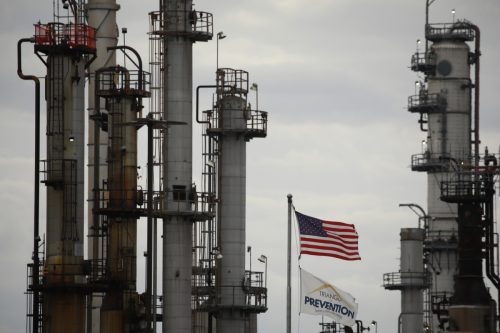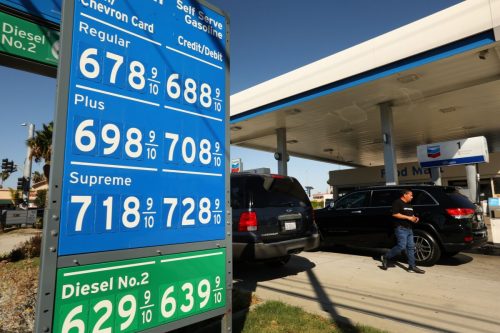The gasoline shortage crisis in the United States is set to worsen in the coming weeks and months, with seasonal fuel inventories dropping to their lowest levels in 13 years.
New York and most states on the east coast of the United States are expected to be at risk of severe fuel shortages this summer, with the entry into force of the decision to ban shipments of Russian diesel, according to Bloomberg.
The world is waiting for the European ban on Russian diesel shipments transported by sea to enter into force at the beginning of February 5, 2023, within the framework of tightening sanctions against Russia to end the ongoing Ukrainian war.
The beginning of the ban
Observers fear the repercussions of this decision on the troubled continent of Europe, which is trying to search for alternatives to Russian diesel in other countries such as Saudi Arabia and India, after it relied on it by 40% before the Ukrainian war.
The ban decision will lead to a decrease in the supply of raw materials used in the gasoline mix, especially naphtha, which is indispensable in fuel refining and some chemical industries, according to what was monitored by the specialized energy platform.
European refineries will also enter the periodic maintenance season during the spring. This makes it likely that the quantities of gasoline produced will decrease for the benefit of the Union countries or for the benefit of the eastern coast states in the United States.
Longer maintenance season

New York State and most of the states on the east coast of America depend on gasoline reserves coming from Europe via Atlantic Ocean tankers each summer season.
The United States increased European gasoline imports during the winter season more than usual; Because of the Elliott blizzard, which disrupted most US refineries from production, and severely damaged them.
The current refinery maintenance season is not expected to end at the regular times known in the sector, and it may continue longer than usual, due to the damage to most of the US Gulf Coast refineries.
And Elliott storm caused a decrease in the total refining capacity in the United States by 1.5 million barrels per day, during the month of December 2022.
Some US companies have also postponed plans for some repairs and maintenance during the years 2020 and 2021. Due to the Corona pandemic and the repercussions of the closure, which greatly weakened the demand for fuel.
Intensifying maintenance will affect the increase in gasoline and diesel supply pressures in America, in addition to the risks of seasonal decline in stocks to the lowest level since 2013; What threatens to continue rising prices in many US states.
Gasoline stocks are down 10%.
Gasoline stocks in the US are currently 10% lower than normal, while diesel stocks are down even further, up to 20%; This threatens to exacerbate the gasoline crisis during the heavy consumption summer.
Gasoline prices in Texas rose to $3.07/gallon in the last week of January 2023, 44 cents higher than the average recorded during December 2022.
The average price of gasoline in Oklahoma rose to $3.31/gallon, an increase of 45 cents, according to data monitored by the specialized energy platform on January 24, 2023.
Gasoline prices in America witnessed a sharp rise in June 2022, then prices calmed down slightly in the following months, until the end of the year.
Gasoline price forecasts in 2023

The average price of gasoline in the US was about $3.97/gallon, with the exception of California where the average is always higher.
The forecast for gasoline prices during 2023 ranges between $3.39 and $3.49/gallon in 2022, according to estimates from the US Oil Price Information Service (OPIS).
US gasoline consumption decreased to 8.7 million barrels per day in 2022, 600 thousand barrels per day less than its average of 9.3 million barrels per day during the period from 2016 to 2019.
US consumption is expected to continue to rise to 8.8 million barrels per day, equivalent to 365 million gallons per day, according to the specialized energy platform.
High refining margins
The rise in final consumer prices of oil derivatives prompted an increase in US oil refining margins to their highest levels in 3 months, during the last week of January 2023.
US margins recorded approximately $42.41 a barrel on January 24, 2023, which is the highest level since October 2022.
It is not usual for refining margins to rise during the month of January of each year, due to the cold weather, which leads to a decrease in movement and travel.
The average US refining margins during the month of January and over the past 5 years were approximately $15.56, according to data from the specialized company, Refinitiv Eikon.
The data recorded on refining margins in January 2023 means that they increased by nearly 200%, compared to their average in 2018, according to the calculations of the specialized energy platform.
US demand for European gasoline imports also pushed up refining margins in Europe, during January 2022, to their highest levels in 7 years.
The average refining margins in Europe, during the first 3 weeks of January 2023, were nearly $13 a barrel, which is the highest seasonal average recorded in January since 2016.
Refineries are still suffering
The largest US refinery (Port Arthur), Texas, has restored normal activity since January 25, 2023, while most refineries are still suffering from the repercussions of Storm Elliott and its aftermath.
Port Arthur is the largest US refinery, with a refining capacity of approximately 626,000 barrels per day, through Motiva Enterprises, owned by the giant Saudi Aramco.
American refineries are facing additional pressure due to the flight of neighboring Canadian crude oil to Asia; In search of new buyers, they might delay his return to North America, or make his return more expensive through more competitive prices.
Some Asian traders contracted to buy 7 million barrels of Canadian crude for loading in February 2023, the most Asians have bought since 2021, according to Bloomberg.
related topics..
Also read..

Leave a Reply